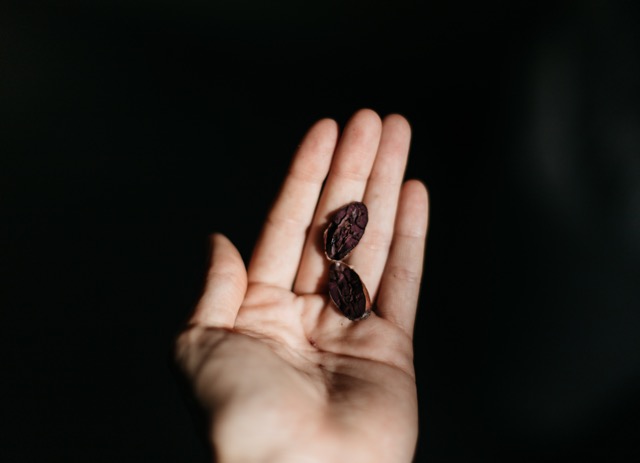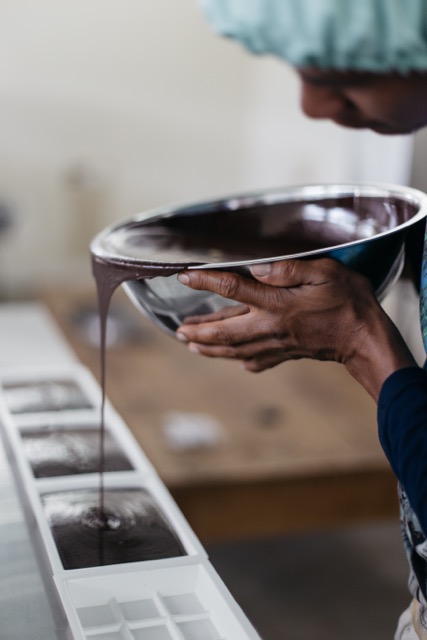All words and photos by Madie McKay who traveled to Ecuador to live and work at a cacao co-operative. She shares her experience and the beauty of the chocolate bar we have come to love.
Chocolate is a romantic, indulgent expression of love. It is the elegant and ethereal second act. It is euphoria in its purest. But what is it that makes chocolate so amazing? Cacao beans.
Cacao made the cut as one of the world’s leading “superfoods” or “superfruits,” a fancy way of saying it’s really good for you. Superfoods are classified by high nutritive values most often reflected by their antioxidant capacity and naturally occurring good-for-you compounds. But behind the health of superfoods is often an overlooked and untold story: the people who produce them.
I had the amazing good fortune to study abroad in the beautiful country of Ecuador which is home to some of the best cacao in the world. Contrary to popular belief, there are findings that the Ecuadorean Amazon was the first place cacao was consumed 5,500 years ago. With a long history of cacao, it only makes sense that it is one of Ecuador’s primary exports. However, since it is also a commodity export, the Ecuadorean economy becomes increasingly more dependent on U.S. and European demand.
So why Ecuador? Most people can’t identify the tiny country on a map much less explain the history of its imports. Ecuador is a small, but mighty biodiverse country. From the cold, dry Andes to the dense, humid jungle, Ecuador is home to thousands of varieties and species of flora and fauna. Its ecological richness is evident in just a short drive down the road or a quick hike up a mountain. Ecuadorean cacao, then, has a unique flavor profile because it grows in various microclimates.
I was first introduced to cacao in a place called Mindo, a quaint and eclectic town lodged in the Andes. We heard it was home to the best brownie in the world. In the world, I remember thinking. That’s quite a lofty statement and as a self-proclaimed chocolate critique, I had my doubts. So my friends and I determined to find this world-acclaimed brownie. We meandered to El Quetzal café on our very first night in the country. They brought out a perfectly square brownie oozing with chocolate with chocolate sauce spilling over the sides and onto the plate. Needless to say, we still have dreams about that brownie. And it was there my love story with Ecuadorean chocolate began.


The adoration blossomed in a place saturated with diversity and humidity. Cacao thrives in rich soils and tropical climate, both of which Ecuador has plenty. When it came time to pick a topic and place for a month-long research project (a part of my program requirement), I ventured to the Ecuadorean Amazon to volunteer at a cacao cooperative called Tsatsayaku (SAH-SAH-YAH-COO), which in the indigenous language of Kichwa translates to “river of sand.” Here, I lived with a rural family and then in a beautiful hostería named Oro y Luna.
The Amazon started to feel like home and I freely embraced life in the “campo.” I would chop down cacao from the tree with a machete, crack it open, and eat the flesh and juice around the cacao bean. I would munch on cacao nibs all day after they finished drying in the sun in the greenhouses. I would eat chocolate by the spoonful after we processed the cacao and made it into a paste.

I especially began to love visiting the farms of the people who harvested the cacao. Seeing the communities of people dedicated to the integrity of the land was a beautiful and foreign concept to me. Farmers tend to their crops on “chakras,” or roughly translated, “the practice of sustainable agroforestry wherein subsistence crops (yucca/manioc, vegetables) are grown alongside tree crops such as cacao, guayusa, banana and coffee, and medicinal plants.” Unlike U.S. agriculture, these chakras allow the crops to grow in a more sustainable, diverse way. Almost wild. As a result, the cultivators have a deep connection to the land which is reflected in the indigenous phrase “Sumak Kawsay,” or good living.
Tsatsayaku and many other agricultural based co-operations aim to empower communities by purchasing the harvesters’ cacao at fair and living wages, hence the term ‘fair trade.’ Though fair trade is not a perfect system, it is trying to improve the lives of those who work the land to line the aisles of your local Whole Foods Market with delicious chocolate bars. I encourage you to seek out Fair Trade Certified products when shopping because even the incremental improvements make a big difference in the lives and homes of the people I came to know and love.
A home that I am transported to every time I eat a brownie or bite into a rich, dark chocolate bar. I’m reminded of my friend Ramón gleaming toward me while he stands next to his award-winning cacao trees, and sweet Jordi, the three-year-old who confidently and expertly carried a mini machete as he followed his grandfather around the family farm all day long. These are the memories I made and the stories I came home to tell – of a love I can share every day everytime I pass a little piece of chocolate to a loved one.
It is my silent way of passing the connection to the Ecuadorean jungle and honoring all those who once were strangers in a distant land, but embraced me as family.
So the next time you indulge your sweet tooth with any kind of chocolate, remember what it took to get that bite of happiness to you.
__________
[1] Ellen, Buffy. “Cacao: 5 Little Known Benefits of This Amazonian Superfood .” Https://Begoodorganics.com/Blogs/Subscriber-Only-Recipes/7991527-Cacao-5-Little-Known-Benefits-of-This-Amazonian-Superfood, Begoodorganics
Want more health hacks and wellness insights? We got you covered. You'll also receive a code for 15% off your first order!

